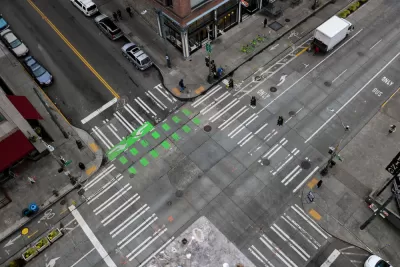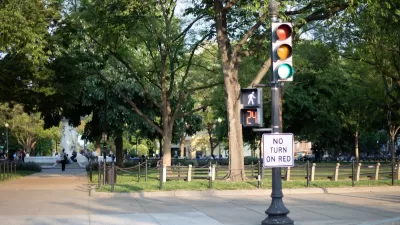Every new traffic light in the city will be required to install ‘No Turn on Red’ signs, a tactic shown to reduce collisions.

All newly installed or repaired traffic signals in Seattle will bar drivers from turning right on red. As Ryan Packer points out in The Urbanist, “The change doesn’t mean that right-on-red will be restricted every single intersection in Seattle anytime soon, but rather that every time a project within the department deals with replacing or modifying a traffic signal, SDOT will have to find a reason justifying not to add ‘no turn on red’ signage.” Allowing cars to turn right on red will now require a “significant operational reason.”
In Washington, D.C., banning right turns on red resulted in a 97 percent reduction in driver-to-driver conflicts and a 92 percent reduction in vehicle-pedestrian conflicts. According to a study published in the Institute of Traffic Engineers (ITE) journal, “These improvements came at overall minor impacts to traffic operations. These findings have helped the District identify a low-cost safety tool that will help in its pursuit of Vision Zero.”
Packer adds that “The new policy will not apply when the city does routine maintenance, or when it modifies signals to add Accessible Pedestrian Signals (APS), which provide low-vision people auditory clues that it’s safe to cross the street. The rule will also not apply when signal timing is the only thing about a signal that is modified.”
SDOT expects roughly 150 intersections will have restricted turns on red by the end of this year, “still just a fraction of the over 1,000 signalized intersections that SDOT maintains citywide.”
FULL STORY: No Right Turn on Red Is Now the Default in Seattle

Maui's Vacation Rental Debate Turns Ugly
Verbal attacks, misinformation campaigns and fistfights plague a high-stakes debate to convert thousands of vacation rentals into long-term housing.

Planetizen Federal Action Tracker
A weekly monitor of how Trump’s orders and actions are impacting planners and planning in America.

In Urban Planning, AI Prompting Could be the New Design Thinking
Creativity has long been key to great urban design. What if we see AI as our new creative partner?

King County Supportive Housing Program Offers Hope for Unhoused Residents
The county is taking a ‘Housing First’ approach that prioritizes getting people into housing, then offering wraparound supportive services.

Researchers Use AI to Get Clearer Picture of US Housing
Analysts are using artificial intelligence to supercharge their research by allowing them to comb through data faster. Though these AI tools can be error prone, they save time and housing researchers are optimistic about the future.

Making Shared Micromobility More Inclusive
Cities and shared mobility system operators can do more to include people with disabilities in planning and operations, per a new report.
Urban Design for Planners 1: Software Tools
This six-course series explores essential urban design concepts using open source software and equips planners with the tools they need to participate fully in the urban design process.
Planning for Universal Design
Learn the tools for implementing Universal Design in planning regulations.
planning NEXT
Appalachian Highlands Housing Partners
Mpact (founded as Rail~Volution)
City of Camden Redevelopment Agency
City of Astoria
City of Portland
City of Laramie





























